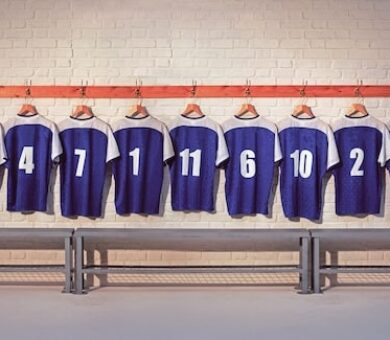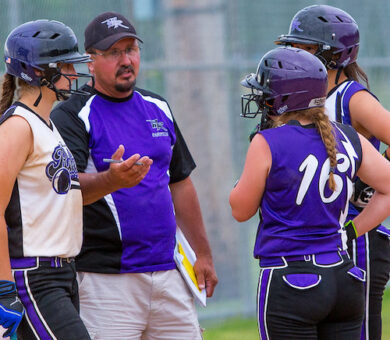7 Tips For Building Confidence in Your Athletes
Confidence in athletics is as important as skill level. Even the most gifted and talented athletes can lose confidence. As a high school coach, I’m sure you have experienced entire teams, or individuals, losing confidence in themselves or each other. The effects are sometimes mind-blowing as outcomes of drills, games, and championships fall apart.
When wins and losses are on the line, every player’s confidence is crucial. Here are seven tips for building, or rebuilding, confidence with your individual players and with teams.
Praise Positive Body Language
When you see body language that exudes confidence, praise it. This body language is not that of an athlete who brags or boasts of a skill level that is not present or who brings about a false sense of confidence. In fact, for many athletes, confidence is simply a quiet aura – it just presents itself in their actions.
A body language that demonstrates confidence is one where the athlete is upbeat, positive, self-assured, and believes in their own abilities and/or the abilities of the team. This athlete approaches competitions and practice with a no-fear, no-intimidation, no-worry-about-outcomes, no-negativity, and no-victimhood mentality. It’s a convincing, bring-it-on approach that is contagious.
As a coach, if you see this body language and praise it, there is an increased likelihood that the behavior will continue and even spread throughout teams.
Remind Your Players of Past Success
When you see the shoulders start to dip and the confidence start to leave one of your players, or your entire team, remind them of past successes, even if those successes are smaller in scale than the task at hand. Everyone has had success before.
Be the coach who can bring those memories to the forefront, with positive intentions, when your team needs that boost.

Go Back to the Fundamentals
If the confidence scales are tipping downward, take the team back to the basics. Start with drills the team likes and/or drills they can master quickly. Then rebuild in a sequence that can build back the confidence.
For many coaches, this means days where practice looks like the basics — back to square one. This small shift allows the athletes to refocus on technique and worry less about what they are currently fearing or doubting.
Let Them Breathe
Sometimes the pressure of athletics builds to a point where the athletes lose faith that they can accomplish the goal. The coach can lift the pressure for a day and allow the athletes to reestablish their love of the sport.
Sometimes athletes forget their love of sport because it becomes too much for them to handle. A simple release can help with this situation. Giving them a day off is one option that can be effective, but it doesn’t require an off-day.
You could just bring a little fun to practice. This is not to be confused with a “fun day” where nothing gets done. It is a practice set up with competitions and drills that the athletes enjoy. Every team has favorite drills. These practices are just as competitive as any other practice. They just are full of the most popular drills and competitions.
Change the Environment
A change in venue allows the mind to have a fresh start in a new environment, instead of dwelling on the one that currently causes the lack of confidence.
If the location can’t be changed, sometimes adjusting certain elements within the practice can still bring about the same effect. For example, I have seen music or obnoxious crowd noise piped into the practice, causing a diversion for the practice players.
The music gets them hyped, or the crowd noise causes some fun banter between competitors, and it changes the dynamic of the practice. Soon, lack of confidence is not the main issue anymore, and overcoming the new challenge takes over.
Show / Tell Them You Believe in Them
When an athlete loses confidence, this is probably the time they need you the most. Their confidence is shot. They blame themselves or someone else, yet all they are seeking is confirmation that the coach still believes in them. While some of them never show this need, you know it exists. Most players want to please the coach. When they know deep down that a coach, through actions and voice, believes in them, their confidence grows.
It has to be genuine, though, or it won’t work. Players can feel when the coach is not being real with them.
If you can tell your team and, even better, show them that you believe in them, confidence can reappear quickly.
Create Situations That Bring Success
When you know the strengths of each athlete, you can help build confidence by putting them in situations where you know they’ll be successful. You determine these situations based on your past experience with the athletes and the challenge you present matches their strengths.
In this way, you are not giving them an out or being easy on them. Instead, you are reminding them of their talent and skill level without saying it.
Practice, Practice, Practice
Practice the pressure situations. Most coaches wait until the end of practice to review special situations or championship-type scenarios. The problem with always ending practices with the most pressurized and specialized drills is that, if drills earlier in practice exceed their allotted time, the things at the end of practice get omitted.
Insert special and pressure situations throughout the practice and build the intensity from there. Most athletes love these situational drills because they love to be competitive. It also gives those who are not as good at pressure situations more time to practice them. One success can lead to another, and true confidence can be built, or rebuilt, in small steps every day.
One step at a time is the most productive way to build confidence. If it is too easy, there will be a false sense of confidence. However, if it is built in succession with players getting challenged and pushed in a thought-out plan, the confidence build will start stronger and remain stronger when the tough times hit.




